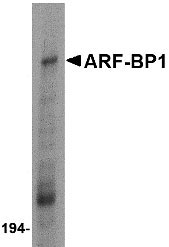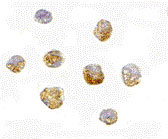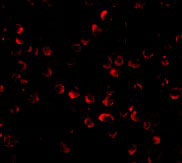ARF-BP1 Antibody
- SPECIFICATION
- CITATIONS
- PROTOCOLS
- BACKGROUND

Application
| WB, IF, ICC, E |
|---|---|
| Primary Accession | Q7Z6Z7 |
| Other Accession | NP_113584, 61676188 |
| Reactivity | Human, Mouse, Rat |
| Host | Rabbit |
| Clonality | Polyclonal |
| Isotype | IgG |
| Calculated MW | 481891 Da |
| Application Notes | ARF-BP1 antibody can be used for detection of ARF-BP1 by Western blot at 1 µg/mL. Antibody can also be used for immunocytochemistry starting at 5 µg/mL. For immunofluorescence start at 20 µg/mL. |
| Gene ID | 10075 |
|---|---|
| Other Names | ARF-BP1 Antibody: MULE, Ib772, LASU1, UREB1, HECTH9, URE-B1, ARF-BP1, HSPC272, KIAA0312, KIAA1578, E3 ubiquitin-protein ligase HUWE1, ARF-binding protein 1, HECT, UBA and WWE domain containing 1 |
| Target/Specificity | HUWE1; |
| Reconstitution & Storage | ARF-BP1 antibody can be stored at 4℃ for three months and -20℃, stable for up to one year. As with all antibodies care should be taken to avoid repeated freeze thaw cycles. Antibodies should not be exposed to prolonged high temperatures. |
| Precautions | ARF-BP1 Antibody is for research use only and not for use in diagnostic or therapeutic procedures. |
| Name | HUWE1 |
|---|---|
| Synonyms | KIAA0312, KIAA1578, UREB1 |
| Function | E3 ubiquitin-protein ligase which mediates ubiquitination and subsequent proteasomal degradation of target proteins (PubMed:15567145, PubMed:15767685, PubMed:15989957, PubMed:17567951, PubMed:18488021, PubMed:19037095, PubMed:19713937, PubMed:20534529, PubMed:30217973). Regulates apoptosis by catalyzing the polyubiquitination and degradation of MCL1 (PubMed:15989957). Mediates monoubiquitination of DNA polymerase beta (POLB) at 'Lys-41', 'Lys-61' and 'Lys-81', thereby playing a role in base-excision repair (PubMed:19713937). Also ubiquitinates the p53/TP53 tumor suppressor and core histones including H1, H2A, H2B, H3 and H4 (PubMed:15567145, PubMed:15767685, PubMed:15989956). Ubiquitinates MFN2 to negatively regulate mitochondrial fusion in response to decreased stearoylation of TFRC (PubMed:26214738). Ubiquitination of MFN2 also takes place following induction of mitophagy; AMBRA1 acts as a cofactor for HUWE1-mediated ubiquitination (PubMed:30217973). Regulates neural differentiation and proliferation by catalyzing the polyubiquitination and degradation of MYCN (PubMed:18488021). May regulate abundance of CDC6 after DNA damage by polyubiquitinating and targeting CDC6 to degradation (PubMed:17567951). Mediates polyubiquitination of isoform 2 of PA2G4 (PubMed:19037095). Acts in concert with MYCBP2 to regulate the circadian clock gene expression by promoting the lithium-induced ubiquination and degradation of NR1D1 (PubMed:20534529). Binds to an upstream initiator-like sequence in the preprodynorphin gene (By similarity). Mediates HAPSTR1 degradation, but is also a required cofactor in the pathway by which HAPSTR1 governs stress signaling (PubMed:35776542). Acts as a regulator of the JNK and NF-kappa-B signaling pathways by mediating assembly of heterotypic 'Lys-63'-/'Lys- 48'-linked branched ubiquitin chains that are then recognized by TAB2: HUWE1 mediates branching of 'Lys-48'-linked chains of substrates initially modified with 'Lys-63'-linked conjugates by TRAF6 (PubMed:27746020). 'Lys-63'-/'Lys-48'-linked branched ubiquitin chains protect 'Lys-63'-linkages from CYLD deubiquitination (PubMed:27746020). Ubiquitinates PPARA in hepatocytes (By similarity). |
| Cellular Location | Cytoplasm. Nucleus. Mitochondrion. Note=Mainly expressed in the cytoplasm of most tissues, except in the nucleus of spermatogonia, primary spermatocytes and neuronal cells (By similarity). Recruited to mitochondria following interaction with AMBRA1 (PubMed:30217973) {ECO:0000250|UniProtKB:Q7TMY8, ECO:0000269|PubMed:30217973} |
| Tissue Location | Weakly expressed in heart, brain and placenta but not in other tissues. Expressed in a number of cell lines, predominantly in those from colorectal carcinomas |

Thousands of laboratories across the world have published research that depended on the performance of antibodies from Abcepta to advance their research. Check out links to articles that cite our products in major peer-reviewed journals, organized by research category.
info@abcepta.com, and receive a free "I Love Antibodies" mug.
Provided below are standard protocols that you may find useful for product applications.
Background
ARF-BP1 Antibody: The ARF tumor suppressor is a critical regulator of p53 stability. In addition to p53, ARF1 binds to other proteins such as MDM2 and ARF-BP1, a large protein containing HECT, UBA and WWE motifs. ARF-BP1 directly binds and ubiquitinates p53; this activity is inhibited by ARF, indicating that ARF-BP1 is a critical mediator of the p53-dependent and p53-independent tumor suppressor functions of ARF. ARF-BP1 can also catalyze the polyubiquitination of Mcl-1, an anti-apoptotic Bcl-2 family member involved in DNA damage-induced apoptosis. Elimination of ARF-BP1 expression by RNA interference stabilized Mcl-1 protein, resulting in an attenuation of apoptosis induced by DNA-damage agents.
References
Gallagher SJ, Kefford RF and Rizos H. The ARF tumour suppressor. Int. J. Biochem. Cell Biol.2006; 38:1637-41.
Pomerantz J, Schreiber-Agus N, Leigeois NJ, et al. The Ink4a tumor suppressor gene product, p19ARF interacts with MDM2 and neutralizes MDM2’s inhibition of p53. Cell1998; 92:725-34.
Chen D, Kon N, Li M, et al. ARF-BP1/Mule is a critical mediator of the ARF tumor suppressor. Cell2005; 121:1071-83.
Zhong Q, Gao W, Du F, et al. Mule/ARF-BP1, a BH3-only E3 ubiquitin ligase, catalyzes the polyubiquitination of Mcl-1 and regulates apoptosis. Cell2005; 121:1085-95.
If you have used an Abcepta product and would like to share how it has performed, please click on the "Submit Review" button and provide the requested information. Our staff will examine and post your review and contact you if needed.
If you have any additional inquiries please email technical services at tech@abcepta.com.













 Foundational characteristics of cancer include proliferation, angiogenesis, migration, evasion of apoptosis, and cellular immortality. Find key markers for these cellular processes and antibodies to detect them.
Foundational characteristics of cancer include proliferation, angiogenesis, migration, evasion of apoptosis, and cellular immortality. Find key markers for these cellular processes and antibodies to detect them. The SUMOplot™ Analysis Program predicts and scores sumoylation sites in your protein. SUMOylation is a post-translational modification involved in various cellular processes, such as nuclear-cytosolic transport, transcriptional regulation, apoptosis, protein stability, response to stress, and progression through the cell cycle.
The SUMOplot™ Analysis Program predicts and scores sumoylation sites in your protein. SUMOylation is a post-translational modification involved in various cellular processes, such as nuclear-cytosolic transport, transcriptional regulation, apoptosis, protein stability, response to stress, and progression through the cell cycle. The Autophagy Receptor Motif Plotter predicts and scores autophagy receptor binding sites in your protein. Identifying proteins connected to this pathway is critical to understanding the role of autophagy in physiological as well as pathological processes such as development, differentiation, neurodegenerative diseases, stress, infection, and cancer.
The Autophagy Receptor Motif Plotter predicts and scores autophagy receptor binding sites in your protein. Identifying proteins connected to this pathway is critical to understanding the role of autophagy in physiological as well as pathological processes such as development, differentiation, neurodegenerative diseases, stress, infection, and cancer.




